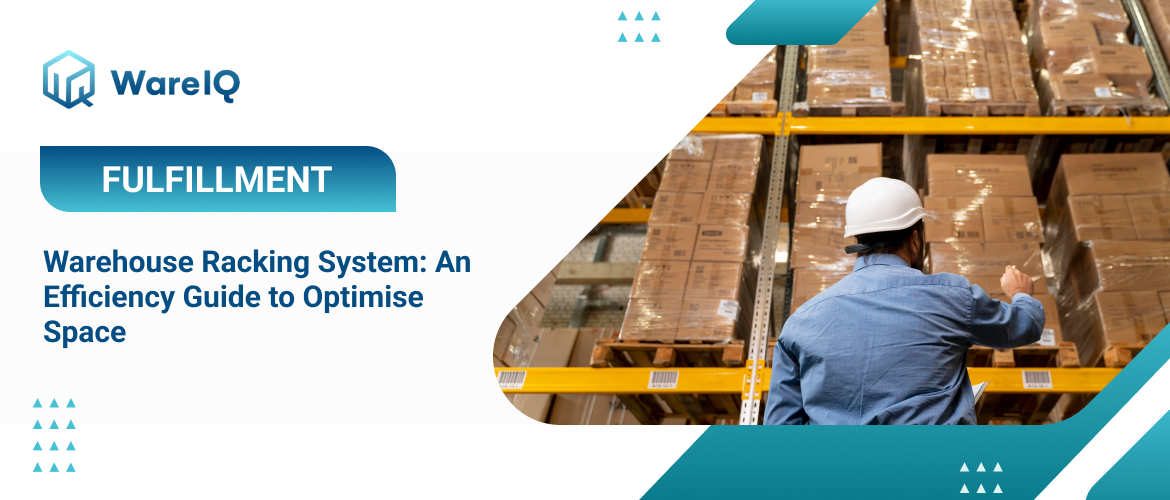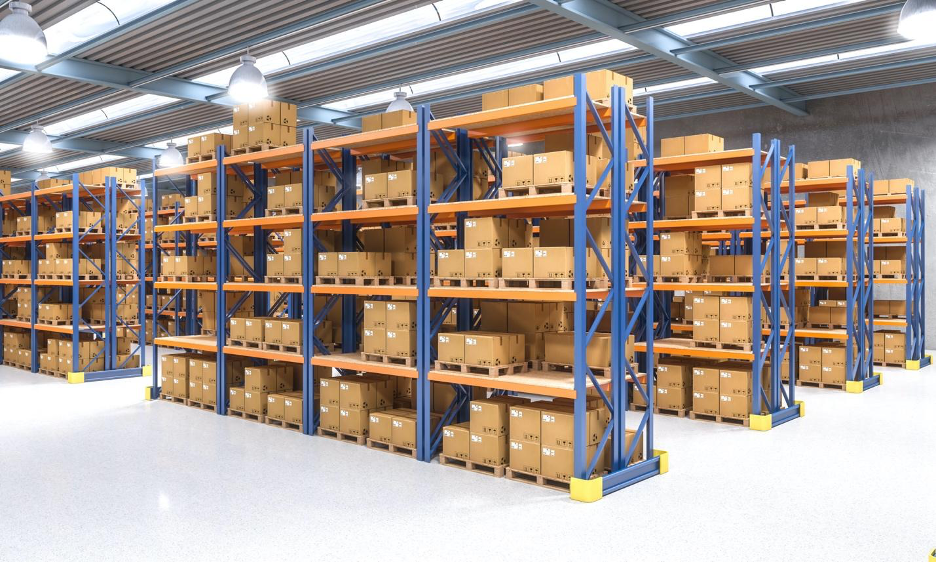Warehouse Racking System: An Efficiency Guide to Optimise Space


A warehouse racking system is crucial in today’s transportation and warehousing environment. Efficient goods storage and mobility are essential for any business that deals with physical goods. Setting up the best warehouse racking system helps to optimise storage space while also simplifying goods movement, resulting in a more efficient supply chain. In this comprehensive article, we’ll delve into the world of warehouse racking systems, profoundly understanding their role, cost considerations, installation processes, load calculations, and safety regulations, ensuring you have all the insights you need.
- What Is a Warehouse Racking System?
- What Is the Purpose of Racking Systems in Warehouses?
- Types of Warehouse Racking Systems and How Much It Costs?
- How to Set Up a Warehouse Racking System?
- How is the Shelving Load Calculated?
- Warehouse Racking Systems and OSHA Inspections
- Conclusion
- FAQs About Warehouse Racking System
- How can warehouse storage systems enhance inventory management efficiency in a modern supply chain?
- What are the key design considerations when selecting godown racks for optimal space utilisation in a storage facility?
- What is a warehouse racking numbering system?
- What is a warehouse racking labelling system?
- What is the warehouse racking system cost?
What Is a Warehouse Racking System?
A warehouse racking system is a meticulously engineered and organised structure within a warehouse or distribution centre. Its primary objective is to maximise storage space efficiency by strategically deploying various racks, shelves, or pallets. Characterised by their versatility, these systems come in multiple configurations, each designed to address specific storage requirements. Warehouse racking systems are the backbone of modern warehousing operations. They transform a static storage space into a dynamic, organised, efficient facility. These systems comprise various components, including beams, uprights, wire decks, and accessories, all meticulously designed to optimise space utilisation.
What Is the Purpose of Racking Systems in Warehouses?
Warehouse racking systems serve multiple crucial purposes within the context of warehousing:
Optimised Space Utilization
Making the most effective use of available space is one of the primary purposes of warehouse racking systems. These techniques take advantage of both vertical and horizontal space, enabling warehouses to store more items without enlarging their physical footprint. Warehouses can accommodate different inventory sizes by vertically stacking things and using adjustable shelving.
Efficient Inventory Management
Efficiently managing inventory is at the core of any successful warehousing operation. Racking systems facilitate systematic inventory storage, retrieval, and management. Each item has a designated location, ensuring easy tracking and accurate inventory counts. This level of organisation minimises the risk of stockouts, overstocking, and lost or damaged items.
Enhanced Accessibility
In the fast-paced world of modern logistics, accessibility is paramount. Warehouse racking systems ensure that stored goods are easily accessible. By using forklifts, pallet jacks, or conveyors, warehouse staff can quickly retrieve products, streamline order fulfilment, and reduce the time it takes to locate specific items.
Improved Safety
An essential component of every activity is safety, especially in the warehouse. Racking systems that are well-planned and up-to-date help keep warehouses safe by decreasing clutter and the possibility of accidents. Products are safely housed, lowering the likelihood of products falling or being harmed.
Flexibility
Warehouse racking systems are incredibly versatile. They can be customised to accommodate a wide array of product sizes, shapes, and weights. Whether storing pallets, cartons, or irregularly shaped items, these systems can be configured to meet diverse storage needs.
Warehouse racking systems come in various types, each suited to specific requirements.
Types of Warehouse Racking Systems and How Much It Costs?
Determining the cost of warehouse racks involves various factors, such as types of racks, dimensions, materials, and suppliers. Below is a table with approximate costs per unit, along with brief descriptions. Let’s explore some common types of warehouse racking systems and their brief descriptions:
| Rack Type | Approximate Cost per Unit | Brief Description |
| Selective Pallet Racks | $75 – $300 per pallet position | Designed for easy accessibility, with each pallet position directly accessible from the aisle. |
| Drive-In Racks | $200 – $500 per pallet position | Suited for high-density storage, allowing forklifts to enter and retrieve items within the rack structure. |
| Cantilever Racks | $150 – $450 per arm | It is ideal for storing long or oddly shaped items with arms protruding from vertical columns. |
| Pushback Racks | $200 – $600 per pallet position | Utilises a gravity-feed system for easy loading and retrieval, making it efficient for high-density storage. |
| Pallet Flow Racks | $150 – $400 per pallet position | It employs gravity rollers to move pallets forward, making it suitable for first-in-first-out (FIFO) inventory systems. |
| Automated Storage Systems | Varies significantly based on complexity | Fully automated systems, including AS/RS (Automated Storage and Retrieval Systems) and robotic solutions. |
How to Set Up a Warehouse Racking System?
Setting up a warehouse racking system involves a systematic approach:
Assessment
Begin by comprehensively evaluating your storage needs, inventory types, and available space. This assessment serves as the foundation for designing an efficient racking system.
Design
Collaborate with professionals, such as warehouse designers and engineers, to create a system tailored to your specific requirements and space constraints. The design should consider factors like load capacity, accessibility, and future expansion.
Procurement
Purchase the necessary racks and equipment from reputable suppliers based on the design specifications. Ensure the chosen equipment aligns with your warehouse’s requirements and budget constraints.
Installation
Assemble and install the racking system following the design plan. This phase involves careful alignment, anchoring, and adherence to safety standards. Proper installation is critical to ensure the stability and safety of the system.
Organisation
Implement a structured approach to categorise and label warehouse storage racks, enabling efficient inventory management. Use barcoding or RFID technology to track items accurately and improve order-picking speed.
Training
Train your workforce to use the racking system safely and efficiently. Emphasise best practices in loading, unloading, and navigating the warehouse to minimise the risk of accidents and damage to goods.
How is the Shelving Load Calculated?
Calculating the load capacity of shelves within a warehouse racking system is critical. The calculation typically considers the following factors:
- Shelf Material: The type and quality of the shelf material, such as steel or particleboard, directly influence load-bearing capacity. Steel shelves, for example, can support heavier loads than particleboard.
- Shelf Dimensions: The shelves’ width, depth, and thickness significantly impact their load capacity. Wider and thicker shelves can typically handle heavier loads.
- Spacing and Supports: The spacing between shelves and the number of supports or beams also affect load capacity. Closer spacing and more supports distribute weight more evenly.
- Uniform Load vs. Point Load: Whether the load is distributed uniformly across the shelf or concentrated at specific points plays a substantial role in determining capacity. Manufacturers typically provide load capacity guidelines specific to their shelving systems.
Professional engineers or rack manufacturers often provide detailed guidelines and load capacity calculations to ensure the safe storage of goods.
Related read: Understanding Wear and Tear Concept
Warehouse Racking Systems and OSHA Inspections
In the world of warehouse racking systems, safety comes first. OSHA (Occupational Safety and Health Administration) laws establish severe criteria to protect worker safety. Compliance with OSHA requirements is vital, as breaches can result in fines and, more importantly, jeopardise warehouse workers’ safety. Regular inspections play a pivotal role in identifying and rectifying potential safety concerns, including damaged racks or overloading. Inspection frequencies may vary.
Conclusion
In conclusion, a well-designed warehouse racking system is the linchpin of efficient and organised warehousing operations. By understanding the basics, cost considerations, installation procedures, load calculations, and adherence to safety regulations, businesses can harness the full potential of these systems to optimise space utilisation and elevate overall supply chain efficiency.
Suggested read: Digital Warehouse for Transforming Storage Solutions
FAQs About Warehouse Racking System
How can warehouse storage systems enhance inventory management efficiency in a modern supply chain?
Warehouse storage systems optimise space utilisation, streamline inventory retrieval, reduce handling errors, enhance visibility, and contribute to more efficient inventory management in the modern supply chain.
What are the key design considerations when selecting godown racks for optimal space utilisation in a storage facility?
Key design considerations encompass rack type, dimensions, load capacity, accessibility, and adaptability to various product types and sizes.
What is a warehouse racking numbering system?
A warehouse racking numbering system assigns unique identifiers to each rack or shelf, simplifying organised inventory management and facilitating easy location tracking.
What is a warehouse racking labelling system?
A warehouse racking labelling system employs labels or barcodes on racks and shelves to provide essential information about the stored items, including SKU, quantity, and location.
What is the warehouse racking system cost?
Warehouse racking system costs vary based on factors such as rack type, size, material, and supplier. Approximate prices range from $75 to $600 per pallet position, with automated systems varying significantly based on complexity.








